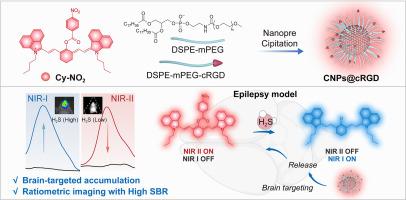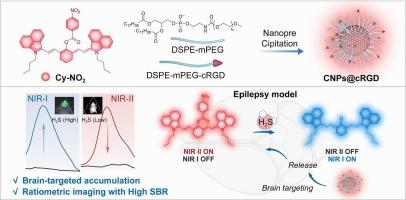脑靶向nir - 1 /NIR-II比例荧光纳米探针原位监测癫痫发作时动态H2S波动
IF 13.2
1区 工程技术
Q1 ENGINEERING, CHEMICAL
引用次数: 0
摘要
与癫痫相关的反复发作与大脑内的氧化还原稳态有着复杂的联系。硫化氢(H2S)是一种重要的细胞内抗氧化剂,可以被认为是癫痫发作的一个指标。然而,缺乏可靠的工具对大脑深部组织中H2S水平的精确体内监测构成了重大挑战。在此,我们开发了一种比率荧光纳米探针CNPs@cRGD,该探针在第一/第二近红外(NIR-I/NIR-II)窗口内发射双通道荧光(F715和F1045),能够准确地对大脑H2S水平进行比率荧光成像,有助于癫痫的诊断。具体来说,CNPs@cRGD是通过将环精氨酸-甘酰-天冬氨酸(cRGD)功能化载体DSPE-mPEG-cRGD加载h2s特异性NIR-I/NIR-II比率报告基因Cy-NO2而获得的。cRGD修饰显著增强血脑屏障(BBB)穿透和CNPs@cRGD在颅内的蓄积,从而促进对脑内病理性H2S水平的敏感荧光比(F715/F1045)增强。更重要的是,CNPs@cRGD通过整合近红外荧光的深层组织穿透、比例信号的高保真度和crgd驱动的脑靶向,实现了癫痫发作和进展过程中大脑H2S波动的准确定量可视化。该智能平台可作为对相关脑疾病进行精确原位监测的有力工具。本文章由计算机程序翻译,如有差异,请以英文原文为准。


Brain-targeted NIR-I/NIR-II ratiometric fluorescence nanoprobe for in situ monitoring of dynamic H2S fluctuations during epileptic seizures
Recurrent seizures associated with epilepsy are intricately linked to the redox homeostasis within the brain. Hydrogen sulfide (H2S) functions as a critical intracellular antioxidant and can be recognized as an indicator of epileptic seizures. However, the absence of reliable tools poses significant challenges for precise in vivo monitoring of cerebral H2S levels in deep tissues. Herein, we developed a ratiometric fluorescent nanoprobe CNPs@cRGD that emits dual-channel fluorescence (F715 and F1045) within the first/second near-infrared (NIR-I/NIR-II) window, enabling accurate ratiometric fluorescence imaging of cerebral H2S levels and facilitating the diagnosis of epilepsy. Specifically, CNPs@cRGD was obtained by loading a H2S-specific NIR-I/NIR-II ratiometric reporter Cy-NO2 with a cyclic arginyl-glycyl-aspartic acid (cRGD)-functionalized carrier DSPE-mPEG-cRGD. The cRGD modification significantly enhanced blood-brain barrier (BBB) penetration and intracranial accumulation of CNPs@cRGD, thereby facilitating sensitive fluorescence ratio (F715/F1045) enhancement in response to pathologic H2S levels within the brain. More importantly, by integrating the deep tissue penetration of NIR fluorescence, the high fidelity of ratiometric signals, and cRGD-driven brain targeting, CNPs@cRGD achieved accurate and quantitative visualization of fluctuations in cerebral H2S during the onset and progression of epilepsy. This intelligent platform may serve as a powerful tool for the precise in situ monitoring of relevant brain diseases.
求助全文
通过发布文献求助,成功后即可免费获取论文全文。
去求助
来源期刊

Chemical Engineering Journal
工程技术-工程:化工
CiteScore
21.70
自引率
9.30%
发文量
6781
审稿时长
2.4 months
期刊介绍:
The Chemical Engineering Journal is an international research journal that invites contributions of original and novel fundamental research. It aims to provide an international platform for presenting original fundamental research, interpretative reviews, and discussions on new developments in chemical engineering. The journal welcomes papers that describe novel theory and its practical application, as well as those that demonstrate the transfer of techniques from other disciplines. It also welcomes reports on carefully conducted experimental work that is soundly interpreted. The main focus of the journal is on original and rigorous research results that have broad significance. The Catalysis section within the Chemical Engineering Journal focuses specifically on Experimental and Theoretical studies in the fields of heterogeneous catalysis, molecular catalysis, and biocatalysis. These studies have industrial impact on various sectors such as chemicals, energy, materials, foods, healthcare, and environmental protection.
 求助内容:
求助内容: 应助结果提醒方式:
应助结果提醒方式:


